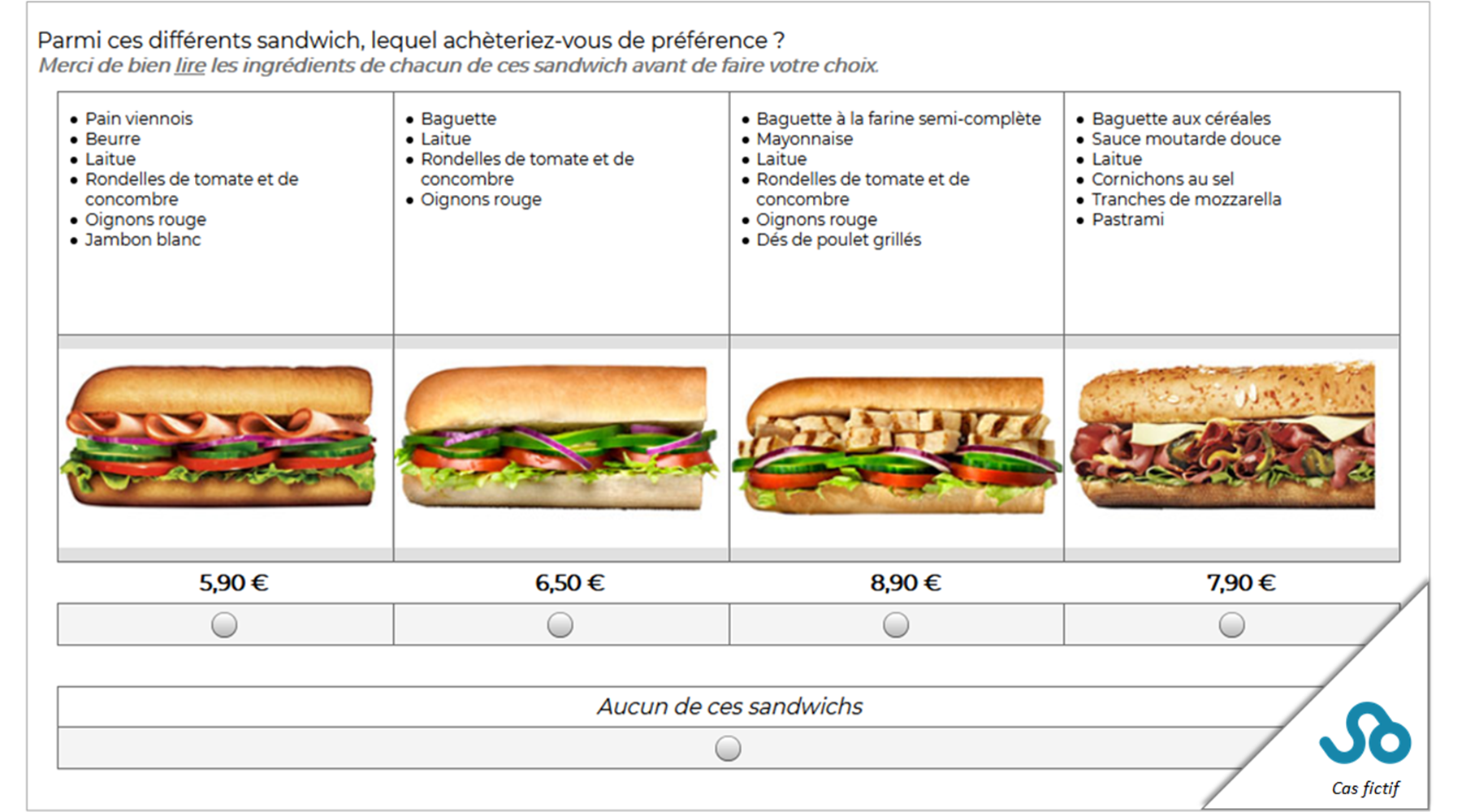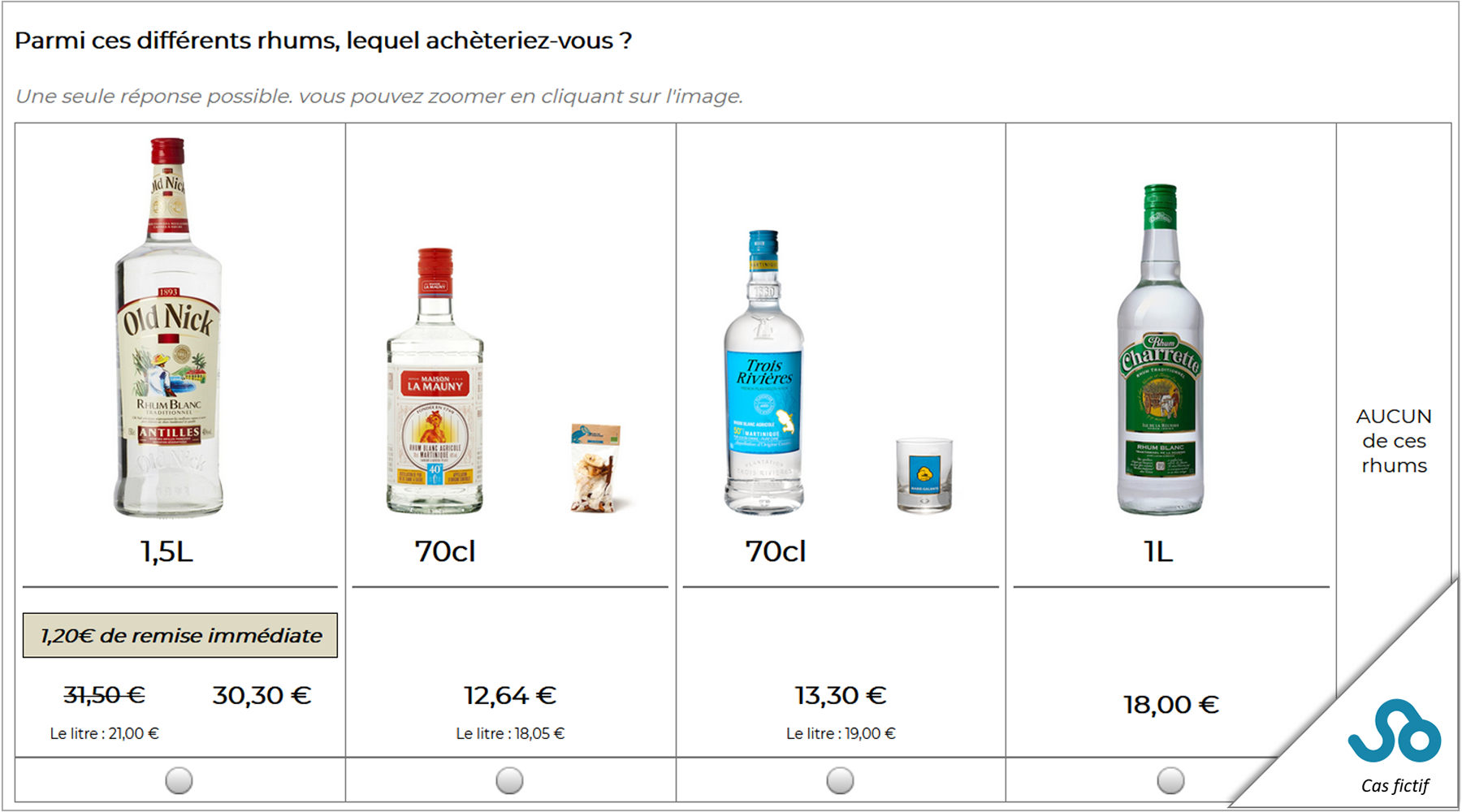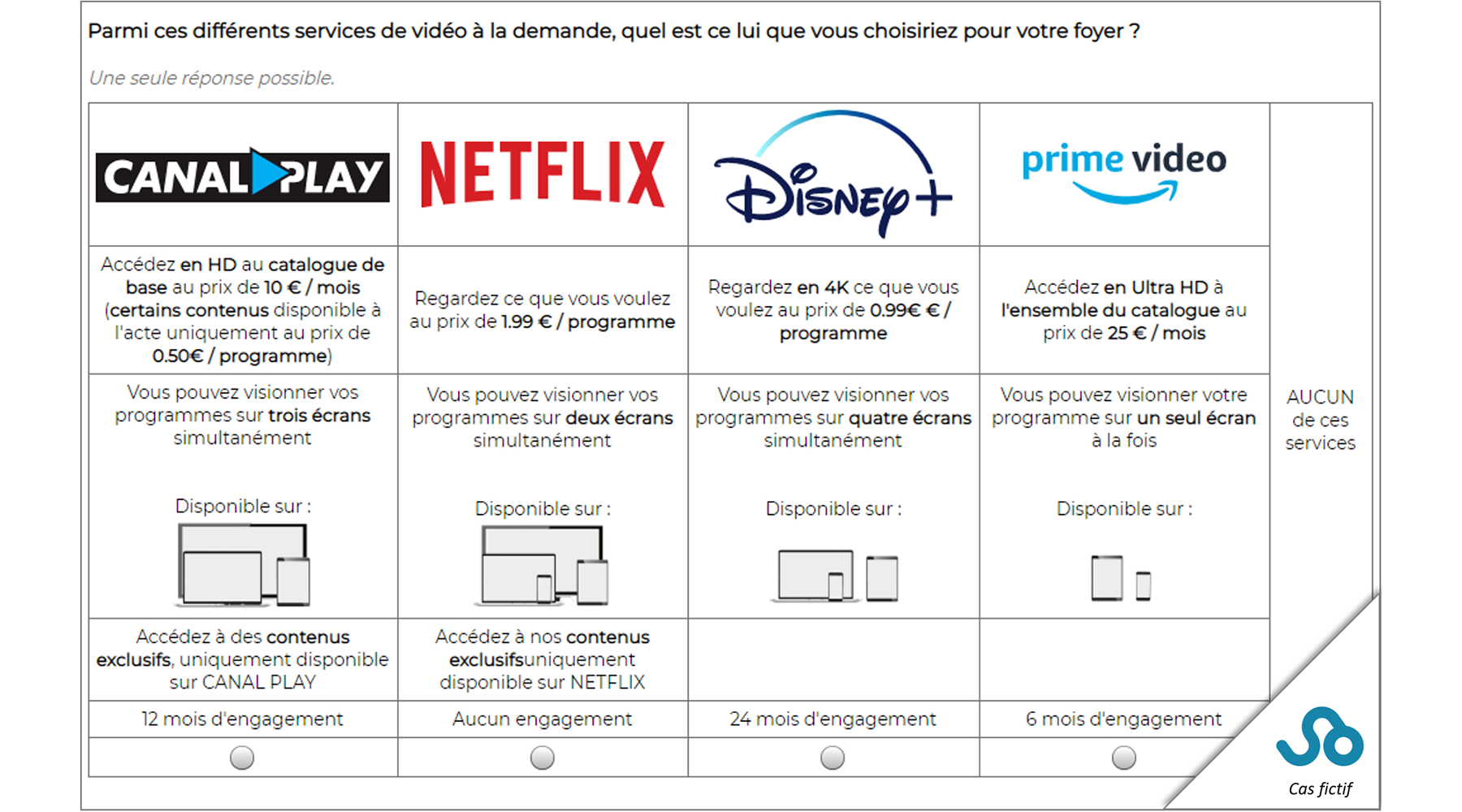How to identify the criteria impacting a consumer in his product or service choice.
The basics
The Choice Based Conjoint approach (CBC) presents interviewees with several products or services to choose from. These products, either complete or not, are made up of 2 or more attributes / variables while the candidate also has the option to not choose any of these.
This question is repeated on several screens based on the experimental design generated prior to conducting data collection. The design presents them with all the variables, their levels, the amount of concepts shown on the screen, the number of screens and the number of interviews to be carried out. In addition, any restrictions and/or exclusions can be implemented.
The way in which a respondent chooses a specific product or service is done by either choosing one proposal and rejecting the others, or by allocating points to the various suggestions presented.
This exercise is repeated on X number of screens (also known as choice tasks), depending on the number of products or concepts presented per screen…
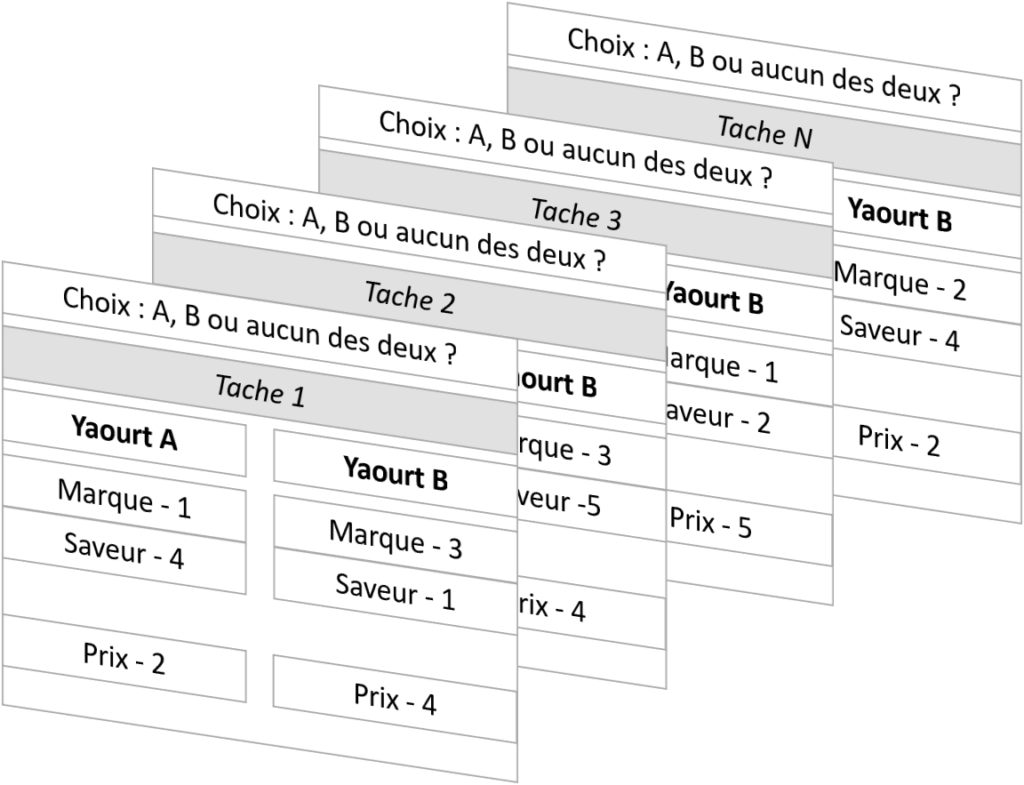
At the end of this process, we are then able to explain the choice of a product or service based on their characteristics.
The CBC, like any conjoint analysis, is based on 4 critical aspects:
- Developing the experimental design
- Programming the task in order to collect information
- Estimating utilities and importances
- Simulating different scenarios in order to analyse the results in depth
These 4 steps all require specific skills and know-how.
Years of experience and continuous research has permitted Solirem employees to fully master these 4 stages. We are one of only a few companies, perhaps the only ones, who will accompany and guide you on all these stages.
The experimental design
The first step is key to the success of a CBC. It has two phases: conceptualizing proposals in terms of their attributes and levels followed by assigning these concepts to the task design.
To develop these choice tasks, various attributes (such as brand, flavor and price) need to be chosen in order to describe the product. However, it is very important to choose which of the levels are able to take on these different attributes. This development stage ensures that the information collected will be in line with the objectives of the study. At the end of the assessment of the utility values, scores will be allocated to each attribute and level.
Attributes/variables sets & corresponding modalities
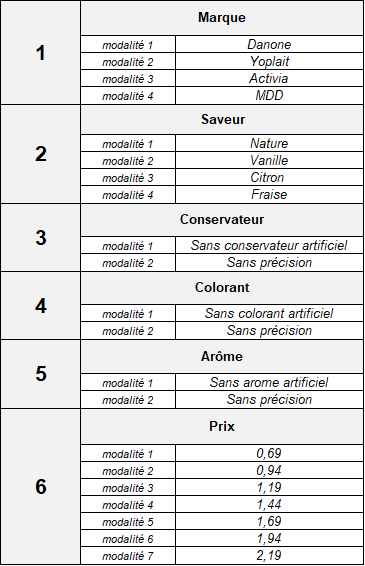
This support is essential, especially when dealing with unusual designs, such when making attributes conditional on to the presence (or absence) of another attribute’s specific level. (download our white paper for more details).
Once the products have been described correctly, we will develop your CBC’s experimental design.
As for any conjoint analysis, the design is built to be orthogonal, that is to say all levels have the same chance of being seen and that two levels on two attributes are never associated more often than any other pair. This essential criteria is what makes it possible to guarantee an unbiased estimate of utilities and importances.
During this development stage, the design is tested, based on a defined sample size, to determine the optimal amount of choice tasks, as well as the number of objects per task your experimental design needs.
This part of the development phase will allow you, together with Solirem’s expert eye, to either confirm and / or enhance the description of the products or services.
An experimental design created by Solirem can be executed by yourself or we can program the exercise in order to provide you with an adapted collection solution.
Collecting information
By entrusting us with the programming of your CBC, whether we have expanded on your design or not, your CBC task choices are presented to your customer as realistically as possible (in other words, they will mimic a real-life scenario as much as possible).
The challenge is to be able to transform attributes from tabular form into a set of visuals. The respondent is presented a product (an offer or a service) corresponding to what
Gross task design he would be able to choose.

Final task design
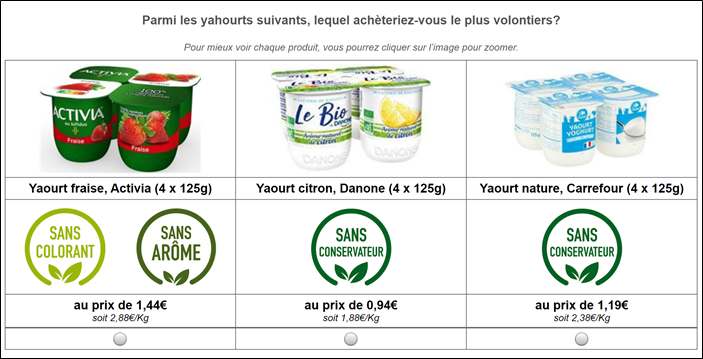
The online questionnaires programming is one of Solirem’s main areas of expertise. Our vast experience allows us to produce any type of CBC for our clients, from the very basic to the most complex and at times in more unconventional formats.
Examples’ slideshow – click on any visual to see more information
Thanks to an efficient and controlled data collection, in accordance with an orthogonal experimental design, we can proceed to an unbiased estimation of the importance and utility values.
Estimating utility values and importance
Solirem employs a modern and efficient approach by using the hierarchical Bayesian utility estimation. This means calculating utilities on an individual level as well as taking both individual responses and global responses into consideration; this allows you to reap all the benefits associated with a solid CBC.
These calculations make it possible to obtain basic information for each respondent: the utility values are associated with each possible level of the experimental design. Stemming from microeconomic theory, a utility value is the digital translation which explains what a level contributes to or withholds from each individual. In other words, when the utility value is positive, the product with this characteristic has more chance of being chosen than when it is negative.
An illustration of the aforementioned example would look like this:
Utility value for each attribute level
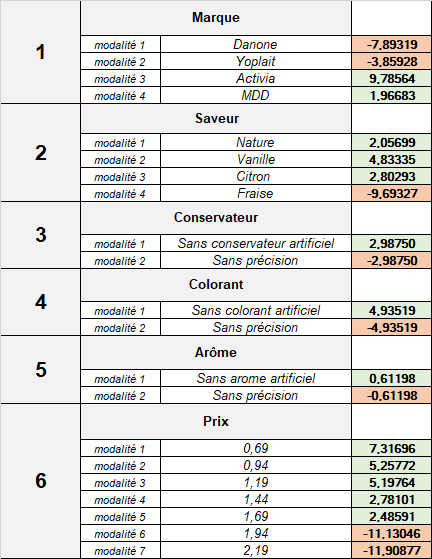
These results show which brand is unproductive, which flavor is underperforming and from which price-level onwards we fall into the none choice.
In addition, the utility values which are estimated at individual level, can also be analyzed through different crosstabs of the study. These tables will make it possible to evaluate:
- The relative value of one level compared to another
- The strength of an attribute (brand, price…) which motivates a choice
- The overall picture based on the targets and useful categories of the study
The utility values can also be used to create consumer segmentations (what types of brand with which format, etc.). Depending on your needs, Solirem is also able to perform any secondary analyses when required.
Finally, these utility values make it possible to calculate the importance of an attribute on an individual level. This score is associated with each variable (for example: a score for the brand, a score for the price and a score for the format) which all add to a total score of 100. The importance is therefore interpreted as the percentage of the choice made by the variable.
Attributes/variables importance scores.
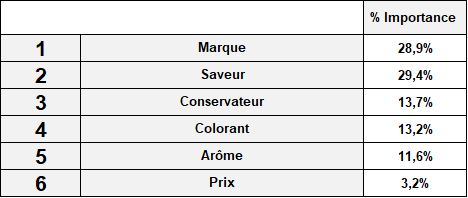
When buying yoghurts, 29% of the decision is made based on the brand and only 3% based on the price (randomly generated data)
Utility values allow us to calculate the overall score of a product so we can compare it to other products by running market simulations.
Simulations
Marketplace simulation is fundamental and the highlight of a CBC methodology. It involves estimating the potential of a particular product, through calculating the utility values for each possible dimension, whether it was presented in the experimental design or not.
Simulation of an absolute or relative potential
- A simulation of an absolute potential means calculating a possible score for a product, independently of any context. In other words, it is a question of evaluating what a product can hope to obtain, while not taking into account the switches likely to be generated by competing products. This approach allows, among other things, to classify objects in the absolute. The sum of scores of the simulated products therefore exceeds 100.
- On the contrary, simulations of a relative potential consist of making an estimate of the market: the sum of the scores is equal to exactly 100 (sometimes with a None). It is interpreted as a market share or a preference share of the object, distributed over all the alternatives. As the calculated utilities are at the individual level, the sum total of these results are equally available at individual level.
Marketshare simulation
- The ‘first choice’ method: this is the most intuitive as it involves assigning the individual’s choice to the simulated product which has the highest total of utility values.
- The ‘probability of choice’ method: less intuitive, but closer to reality. It involves distributing 100% of an individual’s possible choice among the different alternatives in proportion to the utility value of each alternative. Thus, if there are 3 alternatives with the same utility scores, each gets 33.33% choice. If one alternative has a utility twice as high compared to the others, it will get 50% of choices while the other two will “only” get 25% each.
For more details on simulation methods and how they are calculated, we invite you to consult our white paper.
Simulation operating mode
In CBC simulations, the number of possible objects corresponds to the products’ number of levels of the attributes. Consequently, if these products are developed with 5 brands, 4 formats, 6 formulas, 3 promises and 9 price levels, there are potentially 5 x 4 x 6 x 3 x 9 products. To explore these 3240 alternatives, you have to proceed methodically!
The recommended approach is determining one or more base case scenario which to build on from. It is often a question of simulating the current market which exists “for real”. Next, we will introduce modifications step-by-step (to the entire product or part of it, by introducing a new product, etc.) to highlight the effects obtained by the anticipated actions.
Finally, in the last stage, we are able to take the best modified scenario into consideration to examine what would happen if the competition adjusted its own products in response to the modifications introduced.
By doing so, the CBC delivers relevant information in order to make the right decisions.
Complementary statistical analyses
Additionally, depending on your needs and objectives, Solirem is able to carry out secondary analyses if necessary.
Factor analysis of the utility values
- A factor analysis/Factorial analyses can be used to visualize the ways in which the different utility values of the modeled products or services are ordered and related within the CBC

- Furthermore/In addition, we are also able to use this type of analysis to visualize how certain profiles come closer to or move away from certain characteristics.
Classifying utility values and / or importance/significance :
Solirem is able to classify or separate utilities and / or the importance/significance which was calculated in the CBC. This way the analysis makes it possible to capture the different strengths existing in your market. These analyses make it possible to clearly highlight the groups that only work on price or those who prefer certain brands and options, etc. Thereby providing you an analysis with double the amount of benefits: it updates logical specifics to a segment that can therefore be described and targeted and it highlights natural associations for consumers between different levels likely to conceptualise an optimal offer.
Find out more
Solirem’s whilte paper on CBC
Your data will not be released to outside parties.
Solirem complies with French laws relating to privacy protection. According to the Data Protection Act of January 6th, 1978, all personal information is confidential and Solirem is committed to protecting them. You have the right to access, modify, rectify and delete any data concerning you (article 34 of the law “Informatique et Libertés”). You can exercise this right by contacting us: dpo@solirem.fr
